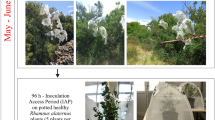Abstract
Bacterial endosymbionts that associate facultatively with insect herbivores can influence insect fitness and trophic interactions. The pea aphid, Acyrthosiphon pisum, can be protected from parasitism by the braconid wasp Aphidius ervi when harbouring particular symbiotic bacteria, with specific endosymbiont coinfections providing almost complete protection. However, studies often quantify aphid mummification with no control over parasitoid oviposition per aphid; thus, if mummy production fails or is low, the causes are often unclear. Here, we show that the high level of protection associated with the coinfecting endosymbionts Hamiltonella defensa and X-type is maintained even when pea aphids are superparasitised. This contrasts strongly with the protection provided by H. defensa alone, which has been shown by others to be overcome by superparasitism. By dissecting aphids exposed to two parasitoid attacks, we reveal that A. ervi deposits eggs equally freely in endosymbiont-infected and uninfected nymphs, and lack of mummification in endosymbiont-protected nymphs arises from failure of the wasp eggs to hatch or emerging larvae to develop.

Similar content being viewed by others
References
Vorburger C (2014) The evolutionary ecology of symbiont-conferred resistance to parasitoids in aphids. Insect Sci 21:251–264
Oliver KM et al (2012) Parasitic wasp responses to symbiont-based defense in aphids. BMC Biol 10:11
Guay J-F, Boudreault S, Michaud D, Cloutier C (2009) Impact of environmental stress on aphid clonal resistance to parasitoids: Role of Hamiltonella defensa bacterial symbiosis in association with a new facultative symbiont of the pea aphid. J Insect Physiol 55:919–926
Clarke HV (2013) Genotypic and endosymbiont-mediated variation in parasitoid susceptibility and other fitness traits of the potato aphid, Macrosiphum euphorbiae. Dissertation, University of Dundee
Caillaud MC et al (2004) Microsatellite DNA markers for the pea aphid Acyrthosiphon pisum. Mol Ecol Notes 4:446–448
Degnan PH, Moran NA (2008) Evolutionary genetics of a defensive facultative symbiont of insects: exchange of toxin-encoding bacteriophage. Mol Ecol 17:916–929
Martinez AJ et al (2014) Aphid-encoded variability in susceptibility to a parasitoid. BMC Evol Biol 14:127
Acknowledgments
We thank Julia Ferrari and Melanie Smee (University of York, UK) for supplying A. pisum clonal lines JF200 and JF45200 and Martin Selby and Glen Powell (Imperial College, London) for supplying A. pisum clonal lines N116, N198 and LL01. Thanks also to Kirstin Buchholz at the James Hutton Institute for the technical support. The study was conceived and designed by SFH and AJK; SFH analysed the data and AJK wrote the manuscript. The susceptibility experiments were conducted by KD for her MRes project with the James Hutton Institute and University of Dundee. The oviposition experiments were conducted by AJK, HVC, CM and RMC as part of research funded by the Scottish Government’s Rural and Environment Science and Analytical Services Division.
Author information
Authors and Affiliations
Corresponding author
Rights and permissions
About this article
Cite this article
Donald, K.J., Clarke, H.V., Mitchell, C. et al. Protection of Pea Aphids Associated with Coinfecting Bacterial Symbionts Persists During Superparasitism by a Braconid Wasp. Microb Ecol 71, 1–4 (2016). https://doi.org/10.1007/s00248-015-0690-8
Received:
Accepted:
Published:
Issue Date:
DOI: https://doi.org/10.1007/s00248-015-0690-8




